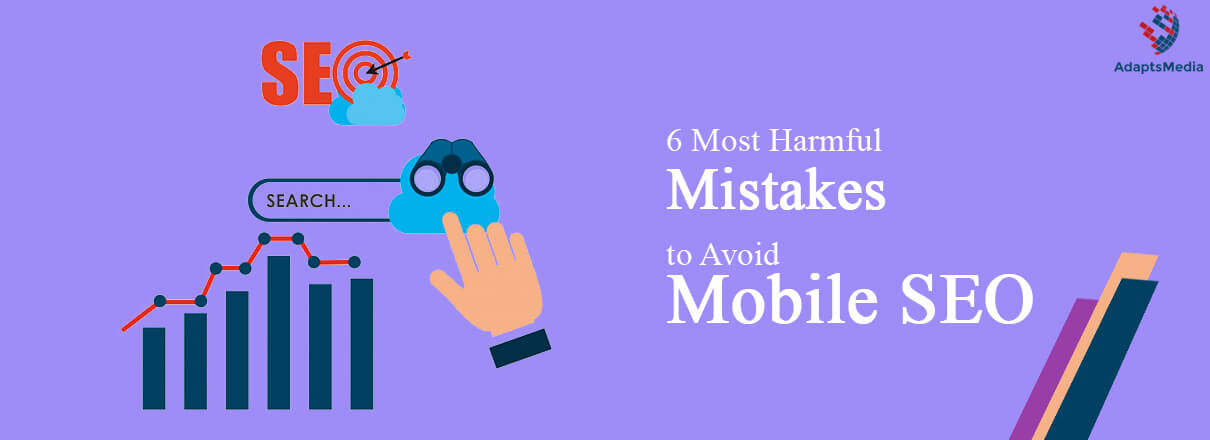Mobile SEO is the art and science of optimizing a website to give mobile and smartphone users the best page experience when they search for any query. Unfortunately, despite being the need of the hour, people are still making many mistakes when it comes to mobile SEO , resulting in loss of traffic, poor search rankings, and ultimately loss of revenue.
Developers make routine changes in the search algorithm to give users the best possible search experience. As more and more people started accessing the internet through their smartphones, the developers changed the algorithm to favour mobile-friendly websites.
The world of SEO underwent a tremendous change when Google announced the switch to mobile-first indexing. Historically, indexing involved using the desktop version of a page’s data. But as more and more people started accessing the internet with their smartphones, the change was inevitable.
So, what did it mean for website users?
It implies that even if your website’s content is fresh and attractive on desktops, your website won’t succeed in making it to the top pages unless it provides a good experience to mobile users.
What are the Most Common and Harmful Mobile SEO Mistakes?
Judging by the current market scenario, webmasters need to start optimizing their site to make them mobile-friendly. Not doing so may damage their customer engagement, lower their search rankings, and prevent their businesses from performing at their maximum potential.
In this article, we’ll list some of the top mobile SEO mistakes you are prone to making.
1. Not Making Responsive Websites
Since the announcement of mobile-first indexing on June 1, 2019, the need for designing responsive websites has become greater.
So what are responsive website designs? Responsive websites are capable of recognizing when the visitors are using smaller platforms to view their content. In addition, they can distinguish between visitors using small and big displays while they attempt to access the website’s information. With the help of this information, responsive websites can optimize the visitor’s page experience by adapting according to the platform that the visitors are using.
The impact of having a mobile-friendly website in the modern business scenario can be huge. Customers often interact and engage with businesses through their online websites – where they make orders, browse products, and interact with the business.
They may do so using smartphones, tablets, laptops, or desktops. Your website, therefore, must be responsive so that it can display its content according to the device that the customer is using.
2. Not Optimizing Site Speed
Google announced their Core Web Vitals update back in May 2020. The metrics that they will be using revolve around the speed of a web page. With the new update about to come into effect, the need to have faster site speeds is greater than ever.
Reports suggest that more than half of the surfers on the internet will not wait for a web page to load if it takes more than 3 seconds. So if your website is slow, then you can lose a lot of potential customers. This will put a huge dent in your business’s overall performance.
So what can you do to improve your site’s speed? Let’s find out.
- Resizing and Compressing Images: The images you use on the website are often the largest element of the page. Resizing and compressing them using image compression tools can provide a much-needed boost to the website’s loading speed.
- Avoid Redirects: While redirects may not be particularly harmful to your website’s SEO, they may prove to be bad for your site speed. Eliminating redirects will not have to waste their time waiting for unnecessary HTTP request-response procedures to complete.
- Improve Your Website’s Codes: Optimizing the website’s codes and simplifying different elements of CSS and JS are some necessary steps that you should take to make your website clean and concise.
- Optimize Server Response Time: Many factors determine a website’s response time. This includes the amount of traffic it receives, its content, and even the hosting company the owner is using. You can start optimizing your server response time by fixing slow database queries, routing issues, or a scarcity of adequate memory.
3. Mobile-Specific Keyword Research
We all know how important keyword research is for SEO. However, as we’re moving from desktop indexing to mobile-first indexing, we need to change how we conduct our keyword research as well.
Proper keyword research in mobile-first indexing is essential as it can improve your website’s rankings on SERP. But keyword research for websites that are targeting mobile users is a bit different from traditional keyword research.
Mobile users primarily use two-thumb typing for their searches and, therefore, use shorter terms. But, on the other hand, they may use long-tail keywords when they’re using voice commands to carry out their searches.
Either way, doing thorough mobile-friendly keyword research is essential, especially now that mobile-first indexing is trending. Not doing so will affect your SERP rankings and overall customer engagement drastically.
4. Having a lot of Interstitials
Intrusive interstitials are the annoying pop-ups, banners ads, and other floating things that you often see on a web page. They cause a layout shift on the page, making it difficult for the user to access and interact with the relevant information.
These interstitials, therefore, reduce a website’s Cumulative Layout Shift (CLS) score – one of Google’s new core web vitals. Google’s algorithm penalizes a website with too many intrusive interstitials as they ruin the users’ experience. So, if your website has intrusive interstitials, Google will not promote your website on SERP. Getting rid of these annoying inhibitions is necessary to increase your website’s performance and rankings.
5. Poor Website Layout
Your website’s layout might look proper on desktops but might not be fully accessible on the phone. In other words, your website’s design should look attractive and function properly on mobile devices as well.
If your website’s design does not offer a great user experience to mobile users, it will affect your engagement and rankings. Because of mobile-first indexing, Google will crawl your site’s mobile version on priority. So if the flaws in designs are apparent, your website won’t be preferred by its algorithm.
You should, therefore, design your website’s layout preferring small-screen devices. Avoid using fancy and unreadable fonts and make sure the font size is appropriate and is not cluttering the web page with too much information.
Additionally, the interactive elements of your website, such as buttons, should be large enough for the visitors to spot and use without any difficulty. Finally, while designing your layout, you’ll need to think like a customer and weed out all the errors you are making.
6. Having Blocked Files on your Website
When there’s a huge difference between your mobile site and your desktop site, your mobile site could have some missing content or files. In such cases, when GoogleBot crawls your website, it will detect all the elements that are not available on the mobile site.
The bot can also detect the restrictions on CSS and JavaScript while crawling your mobile website. Because of these restrictions and blocked files, Google won’t be able to render your website properly. This implies that Google won’t be able to read or understand your website to its fullest. This, in turn, could have a huge negative impact on your SERP rankings.
An easy fix for this grave problem is consulting your “robots.txt” file to ensure that there is no blocked or disallowed content on your website. After that, you can run mobile-friendly tests to ensure that there are no missing objects on your mobile site.
Conclusion
It is really painful to realize that even after spending a considerable amount of time working on your website’s SEO, you are not getting desirable results. A lot of times, the underwhelming results could be because of the mobile SEO mistakes that we’ve mentioned in the article. These errors are not complicated, and it won’t take a long time to fix them. The only problem was not knowing about them, and you eliminated that when you read our article. Happy marketing!
Don’t miss out on the opportunity to gain a competitive edge. Contact our team for expert assistance.

